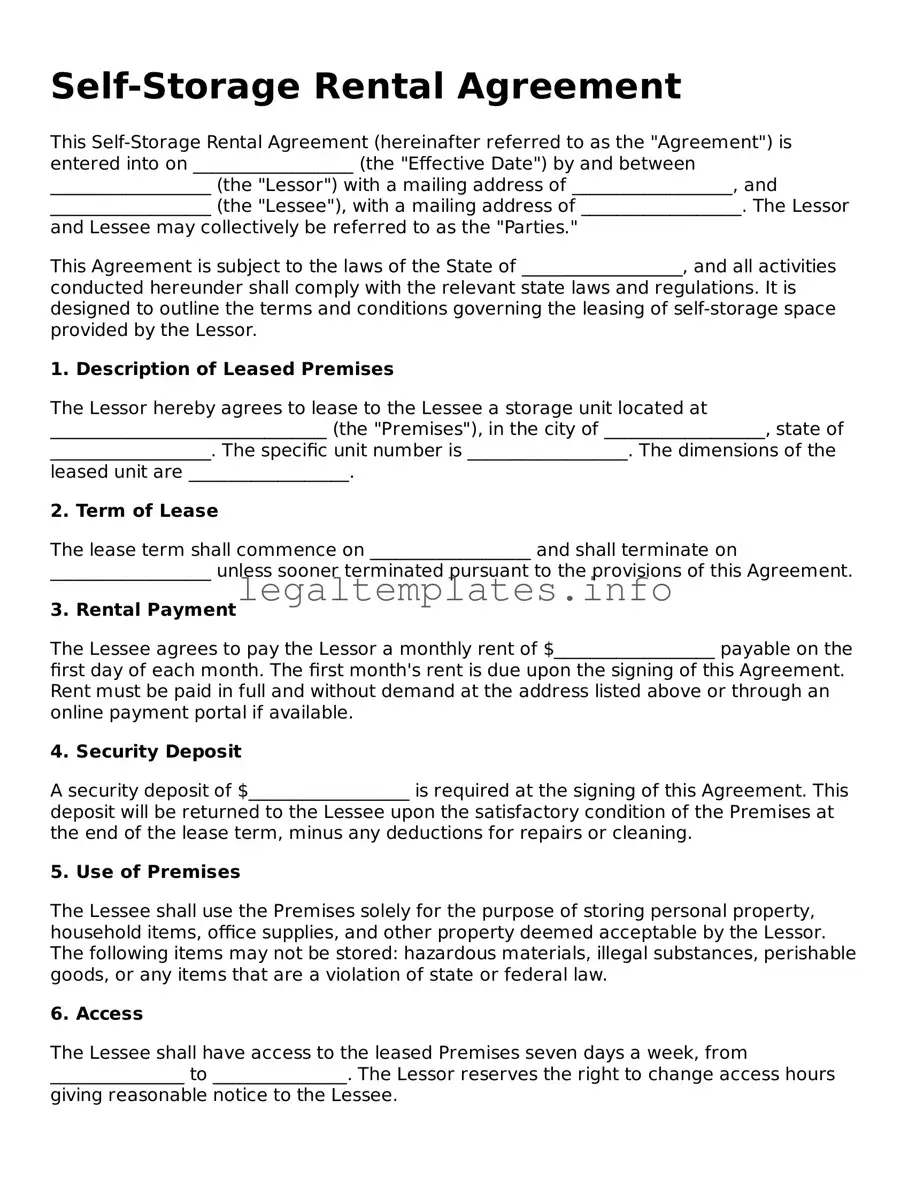Self-Storage Rental Agreement
This Self-Storage Rental Agreement (hereinafter referred to as the "Agreement") is entered into on __________________ (the "Effective Date") by and between __________________ (the "Lessor") with a mailing address of __________________, and __________________ (the "Lessee"), with a mailing address of __________________. The Lessor and Lessee may collectively be referred to as the "Parties."
This Agreement is subject to the laws of the State of __________________, and all activities conducted hereunder shall comply with the relevant state laws and regulations. It is designed to outline the terms and conditions governing the leasing of self-storage space provided by the Lessor.
1. Description of Leased Premises
The Lessor hereby agrees to lease to the Lessee a storage unit located at _______________________________ (the "Premises"), in the city of __________________, state of __________________. The specific unit number is __________________. The dimensions of the leased unit are __________________.
2. Term of Lease
The lease term shall commence on __________________ and shall terminate on __________________ unless sooner terminated pursuant to the provisions of this Agreement.
3. Rental Payment
The Lessee agrees to pay the Lessor a monthly rent of $__________________ payable on the first day of each month. The first month's rent is due upon the signing of this Agreement. Rent must be paid in full and without demand at the address listed above or through an online payment portal if available.
4. Security Deposit
A security deposit of $__________________ is required at the signing of this Agreement. This deposit will be returned to the Lessee upon the satisfactory condition of the Premises at the end of the lease term, minus any deductions for repairs or cleaning.
5. Use of Premises
The Lessee shall use the Premises solely for the purpose of storing personal property, household items, office supplies, and other property deemed acceptable by the Lessor. The following items may not be stored: hazardous materials, illegal substances, perishable goods, or any items that are a violation of state or federal law.
6. Access
The Lessee shall have access to the leased Premises seven days a week, from _______________ to _______________. The Lessor reserves the right to change access hours giving reasonable notice to the Lessee.
7. Maintenance and Alterations
The Lessee shall maintain the Premises in good condition and shall not make any alterations, improvements, or additions without the prior written consent of the Lessor.
8. Liability and Insurance
The Lessor shall not be liable for any loss, claim, damage, or injury of any kind to the Lessee, their guests, or properties. The Lessee agrees to indemnify and hold the Lessor harmless from any claims or damages. Furthermore, it is highly recommended that the Lessee carries insurance for personal property stored within the leased Premises.
9. Default and Termination
In the event of a default by the Lessee, including but not limited to the breach of any terms of this Agreement or failure to pay rent, the Lessor has the right to terminate this Agreement and take possession of the Premises according to state law.
10. Miscellaneous
- This Agreement and any approved attachments constitute the entire agreement between the Parties and supersede all previous discussions, understandings, and agreements.
- Any amendment to this Agreement must be in writing and signed by both Parties.
- This Agreement shall be governed by and construed in accordance with the laws of the State of __________________.
- Failure by either Party to enforce any right or provision of this Agreement shall not be considered a waiver of such right or provision.
In witness whereof, the Parties have executed this Agreement as of the Effective Date.
__________________
Lessor Signature
__________________
Lessee Signature
